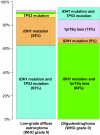IDH1 mutations are early events in the development of astrocytomas and oligodendrogliomas
- PMID: 19246647
- PMCID: PMC2671348
- DOI: 10.2353/ajpath.2009.080958
IDH1 mutations are early events in the development of astrocytomas and oligodendrogliomas
Abstract
IDH1 encodes isocitrate dehydrogenase 1, which participates in the citric acid cycle and was recently reported to be mutated in 12% of glioblastomas. We assessed IDH1 mutations in 321 gliomas of various histological types and biological behaviors. A total of 130 IDH1 mutations was detected, and all were located at amino acid residue 132. Of these, 91% were G-->A mutations (Arg-->His). IDH1 mutations were frequent in low-grade diffuse astrocytomas (88%) and in secondary glioblastomas that developed through progression from low-grade diffuse or anaplastic astrocytoma (82%). Similarly, high frequencies of IDH1 mutations were found in oligodendrogliomas (79%) and oligoastrocytomas (94%). Analyses of multiple biopsies from the same patient (51 cases) showed that there were no cases in which an IDH1 mutation occurred after the acquisition of either a TP53 mutation or loss of 1p/19q, suggesting that IDH1 mutations are very early events in gliomagenesis and may affect a common glial precursor cell population. IDH1 mutations were co-present with TP53 mutations in 63% of low-grade diffuse astrocytomas and with loss of heterozygosity 1p/19q in 64% of oligodendrogliomas; they were rare in pilocytic astrocytomas (10%) and primary glioblastomas (5%) and absent in ependymomas. The frequent presence of IDH1 mutations in secondary glioblastomas and their near-complete absence in primary glioblastomas reinforce the concept that despite their histological similarities, these subtypes are genetically and clinically distinct entities.
Figures


References
-
- Ohgaki H, Kleihues P. Population-based studies on incidence, survival rates, and genetic alterations in astrocytic and oligodendroglial gliomas. J Neuropathol Exp Neurol. 2005;64:479–489. - PubMed
-
- Ohgaki H, Dessen P, Jourde B, Horstmann S, Nishikawa T, Di Patre PL, Burkhard C, Schuler D, Probst-Hensch NM, Maiorka PC, Baeza N, Pisani P, Yonekawa Y, Yasargil MG, Lutolf UM, Kleihues P. Genetic pathways to glioblastoma: a population-based study. Cancer Res. 2004;64:6892–6899. - PubMed
-
- Fujisawa H, Reis RM, Nakamura M, Colella S, Yonekawa Y, Kleihues P, Ohgaki H. Loss of heterozygosity on chromosome 10 is more extensive in primary (de novo) than in secondary glioblastomas. Lab Invest. 2000;80:65–72. - PubMed
-
- Nakamura M, Ishida E, Shimada K, Kishi M, Nakase H, Sakaki T, Konishi N. Frequent LOH on 22q12.3 and TIMP-3 inactivation occur in the progression to secondary glioblastomas. Lab Invest. 2005;85:165–175. - PubMed
Publication types
MeSH terms
Substances
LinkOut - more resources
Full Text Sources
Other Literature Sources
Medical
Research Materials
Miscellaneous

